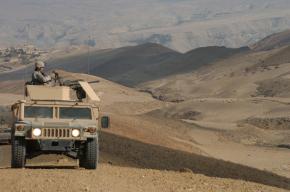Rising toll for U.S. in Afghanistan
reports on a grim milestone for the U.S. military in Afghanistan.
JUNE WAS the deadliest month for U.S. troops in Afghanistan since the war began nearly seven years ago. In all, there were 28 U.S. combat deaths, along with the deaths of 18 international troops, making June the second straight month in which more U.S. and NATO troops were killed in Afghanistan than were killed in Iraq.
The latest casualty figures come on the heels of a new Pentagon report warning that the crisis of the "other occupation" is likely to continue getting worse for U.S. forces. Despite U.S. and NATO efforts to capture and kill key Taliban leaders, the Taliban is likely to "maintain or even increase the scope and pace of its terrorist attacks and bombings in 2008," the report found.
This underlines the growing difficulties that the U.S. faces in a war that was supposed to be over--and the extent to which Afghanistan shouldn't be seen as the "good" war, as some in the antiwar movement consider it, but another front, like Iraq, in the same drive for conquest in the Middle East.

At a Rose Garden news conference, George Bush tried feebly to look on the "bright side" by saying that "it's also been a tough month for the Taliban." According to the Pentagon, more than 400 militants were supposedly killed in Afghanistan in June.
There's no way of knowing, however, how many of those suspected "militants" were actually civilians caught in indiscriminate bombing by U.S. forces--because the U.S. and NATO refuse to count civilian casualties.
Thus, last month, following a Taliban attack on the main prison in the southern city of Kandahar in which hundreds of prisoners were freed, the U.S. military retaliated by unleashing a massive aerial assault on the city. Though leaflets were dropped by U.S. and NATO forces warning residents to flee, it's likely that at least some of those killed in subsequent bombings who the U.S. claimed were Taliban forces were, in fact, civilians.
In late June, United Nations humanitarian affairs chief John Holmes reported that the number of civilians killed in fighting between insurgents and security forces in Afghanistan soared by two-thirds in the first half of this year, to almost 700 people.
Holmes said that most of the casualties were caused by the "insurgents," but "there are also still significant numbers caused by the international military forces." Since January, Holmes said, at least 255 civilians have been killed by U.S., NATO or Afghan government forces.
According to the Pentagon report, not only has the Taliban "coalesced into a resilient insurgency," but the Afghan army and national police are weak due to corruption and insufficient training and equipment. The report also documented a thriving opium trade, numerous human rights abuses, rampant corruption and slow progress in reconstruction.
Attacks on U.S. and NATO forces have become more complex and are likely to increase, said the report, which acknowledged that attacks by the Taliban and other opponents are already up by 40 percent this year from 2007 in areas where U.S. troops operate along the Pakistani border.
MEANWHILE, LIFE for ordinary Afghans remains bleak, with drought in parts of northern and western Afghanistan exacerbating food shortages caused by rising prices for staples such as wheat and rice.
Famine now threatens thousands in places like Ghor province, where more than 80 percent of the population--an estimated 640,000 people--is going hungry, and many people have been forced to eat grass to survive. Twenty percent of children die before their fifth birthday, and about half of the population lives on less than $1 a day.
The country now produces an estimated 92 percent of the world's opium supply, a large increase since the U.S. invasion. And conditions for women--who the U.S. occupation was supposed to have "liberated"--are still dire. In most areas of the country, women must wear the burqa, and reports of self-immolations are on the rise, as women desperate to escape forced and abusive marriages resort to setting themselves on fire.
Reconstruction aid has trickled into the country, and much of it--an estimated 40 percent--simply ends up back in the pockets of "consultants" and contractors from foreign countries. Last month, the group Transparency International ranked Afghanistan 172 out of 180 countries on its "Global Corruption Report 2008."
"This situation continues because, of the billions of dollars that Afghanistan has received from the international community, most of the money has gone into the pockets of the warlords and drug lords that the U.S. and its allies have imposed on our country," Malalai Joya, one of the country's few outspoken female politicians, said in March.
The U.S. response to this humanitarian nightmare appears to be to send more troops to fight.
This week, Admiral Michael Mullen, chair of the Joint Chiefs of Staff, said that military commanders are considering sending additional troops to Afghanistan in 2009--but that conditions in Iraq would have to continue to improve for that to happen. "I don't have troops I can reach for, brigades I can reach to send into Afghanistan until I have a reduced requirement in Iraq," Mullen said.
That attitude seems to be the "conventional wisdom" among politicians of both parties, with Democrats like Barack Obama arguing that Afghanistan should be the "real focus" of the "war on terror." "We cannot win a war against the terrorists if we're on the wrong battlefield," Obama said last year.
But more U.S. troops won't ease the suffering of ordinary Afghans--because "liberating" the people of Afghanistan has never been the real aim of the U.S. war.
As veteran activist and author Tariq Ali puts it, what the U.S. really wants is "to construct an army able to suppress its own population, but incapable of defending the nation from outside powers; a civil administration with no control over planning or social infrastructure, which is in the hands of Western NGOs; and a government whose foreign policy marches in step with Washington's."


